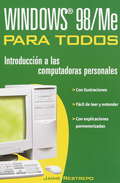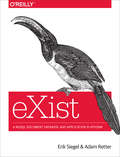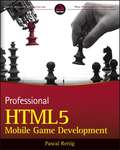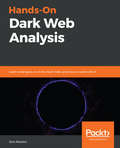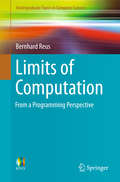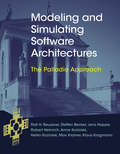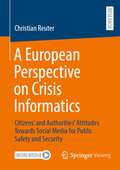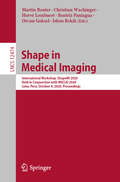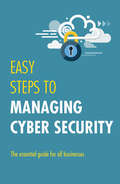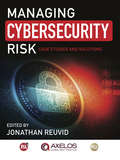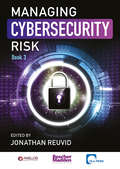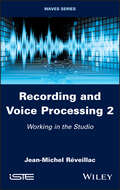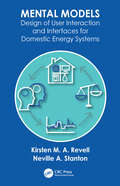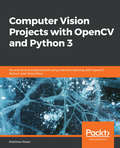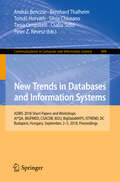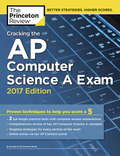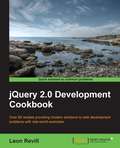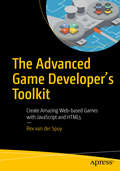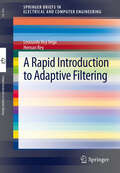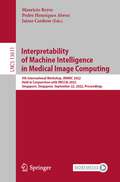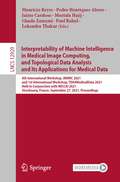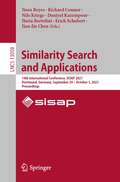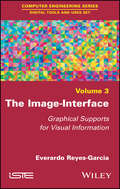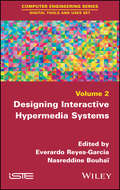- Table View
- List View
Windows 98/Me Para Todos
by Jaime Restrepo¿Sabe cómo más o menos usar las computadoras, pero no sabe cómo sacarle provecho a todo lo que ofrece el sistema operativo Windows® 98/Me?¿No sabe cómo usar el teclado para poder escribir en español más fácilmente?¿No entiende la terminología de lengua inglesa que se usa en la computación?¿Quiere usar el programa Windows® 98/Me para obtener archivos cibernéticos, pero no sabe cómo hacerlo?¿Sabe ya cómo entrar en el Internet pero le cuesta trabajo encontrar todo lo que ofrece?Escrito en español para los hispanoparlantes y con ilustraciones detalladas, Windows® 98/Me para todos es un recurso imprescindible que esclarece todos los pormenores que se necesita saber para usar el sistema operativo de computación más popular del mundo de forma eficaz, ya sea para uso personal, para hacer compras, en el trabajo, para desarrollar un negocio, o para pasar el tiempo.Paso a paso, Windows® 98/Me para todos abarca todo sobre el uso de todas las funciones y las opciones que ofrece Windows® 98/Me: > cómo instalar los programas que funcionan con Windows® 98/Me > cómo usar los CD-ROM y tocar los CD de música grabada> cómo trabajar con los LAN o redes locales. Además, el autor explica el vocabulario inglés que domina la computación al presentarlo de una manera comprensible para cualquiera que no se sienta cómodo con ese idioma. Windows® 98/Me para todos también incluye un útil glosario de terminología de computadoras de interés para los hispanos.En Windows® 98/Me para todos, Jaime Restrepo le abre a la familia hispana la puerta al mundo de la informática, educación, negocios y diversión.From the Trade Paperback edition.
Internet para todos
by Jaime A. Restrepo"Con Internet para todos, dar el primer paso para adentrarse en el mundo de las computadoras no es mas difícil que aprender a montar en bicicleta. Una vez que usted pierda el temor inicial a usarlo, el maravilloso universo del Internet estará a su alcance. " --Enrique Gonzales, Director, Hispanic Online (www. hisp. com) Usando este libro aprenderá todo lo necesario para usar el Internet: Cómo usar los navegadores Cómo usar el correo electrónico Cómo crear una página personal o "home page" Cómo bajar programas del Internet a su disco duro Con ilustraciones detalladas, un glosario de terminología de computadoras, y una lista de lugares del Web para hispanoparlantes, este as el úníco libro que usted necesitará. Deje que, con ilustraciones pormenorizadas, sea su guía mientras explora esta maravillosa tecnología llamada el Internet.
eXist
by Adam Retter Erik SiegelGet a head start with eXist, the open source NoSQL database and application development platform built entirely around XML technologies. With this hands-on guide, you'll learn eXist from the ground up, from using this feature-rich database to work with millions of documents to building complex web applications that take advantage of eXist's many extensions.If you're familiar with XML--as a student, professor, publisher, or developer--you'll find that eXist is ideal for all kinds of documents. This book shows you how to store, query, and search documents with XQuery and other XML technologies, and how to construct applications on top of the database with tools such as eXide and eXist's built-in development environment.Manage both data-oriented and text-oriented markup documents securelyBuild a sample application that analyzes and searches Shakespeare's playsGo inside the architecture and learn how eXist processes documentsLearn how to work with eXist's internal development environmentChoose among various indexes, including a full-text index based on Apache LuceneDive into eXist's APIs for integrating or interacting with the databaseExtend eXist by building your own Triggers, Scheduled Tasks, and XQuery extension modules
Professional HTML5 Mobile Game Development
by Pascal RettigCreate mobile game apps for the lucrative gaming market If you're an experienced developer seeking to break into the sizzling mobile game market, this is the book for you. Covering all mobile and touchscreen devices, including iPhones, iPads, Android, and WP7. 5, this book takes you through the steps of building both single- and multi-player mobile games. Topics include standard patterns for building games in HTML5, what methods to choose for building (CSS3, SVG, or Canvas), popular game engines and frameworks, and much more. Best of all, code for six basic games is provided, so you can modify, further develop, and make it your own. Shows intermediate developers how to develop games in HTML5 and build games for iPhone, iPad, Android, and WP7. 5 mobile and touchscreen devices Explains single-player and multi-player mobile game development Provides code for six basic games in a GitHub repository, so readers can collaborate and develop the code themselves Explores specific APIs to make games even more compelling, including geolocation, audio, and device orientation Reviews three popular open-source HTML5 game engines--crafty. js, easel. js, and enchant. js Covers simple physics as well as using an existing physics library The world is going mobile, as is the game industry. Professional HTML5 Mobile Game Development helps savvy developers join in this exploding market.
Hands-On Dark Web Analysis: Learn what goes on in the Dark Web, and how to work with it
by Sion RetzkinUnderstanding the concept Dark Web and Dark Net to utilize it for effective cybersecurity Key Features Understand the concept of Dark Net and Deep Web Use Tor to extract data and maintain anonymity Develop a security framework using Deep web evidences Book Description The overall world wide web is divided into three main areas - the Surface Web, the Deep Web, and the Dark Web. The Deep Web and Dark Web are the two areas which are not accessible through standard search engines or browsers. It becomes extremely important for security professionals to have control over these areas to analyze the security of your organization. This book will initially introduce you to the concept of the Deep Web and the Dark Web and their significance in the security sector. Then we will deep dive into installing operating systems and Tor Browser for privacy, security and anonymity while accessing them. During the course of the book, we will also share some best practices which will be useful in using the tools for best effect. By the end of this book, you will have hands-on experience working with the Deep Web and the Dark Web for security analysis What you will learn Access the Deep Web and the Dark Web Learn to search and find information in the Dark Web Protect yourself while browsing the Dark Web Understand what the Deep Web and Dark Web are Learn what information you can gather, and how Who this book is for This book is targeted towards security professionals, security analyst, or any stakeholder interested in learning the concept of deep web and dark net. No prior knowledge on Deep Web and Dark Net is required
Limits of Computation
by Bernhard ReusThis textbook discusses the most fundamental and puzzling questions about the foundations of computing. In 23 lecture-sized chapters it provides an exciting tour through the most important results in the field of computability and time complexity, including the Halting Problem, Rice's Theorem, Kleene's Recursion Theorem, the Church-Turing Thesis, Hierarchy Theorems, and Cook-Levin's Theorem. Each chapter contains classroom-tested material, including examples and exercises. Links between adjacent chapters provide a coherent narrative. Fundamental results are explained lucidly by means of programs written in a simple, high-level imperative programming language, which only requires basic mathematical knowledge. Throughout the book, the impact of the presented results on the entire field of computer science is emphasised. Examples range from program analysis to networking, from database programming to popular games and puzzles. Numerous biographical footnotes about the famous scientists who developed the subject are also included. "Limits of Computation" offers a thorough, yet accessible, introduction to computability and complexity for the computer science student of the 21st century.
Modeling and Simulating Software Architectures: The Palladio Approach
by Ralf H. Reussner Steffen Becker Jens Happe Robert Heinrich Anne KoziolekA new, quantitative architecture simulation approach to software design that circumvents costly testing cycles by modeling quality of service in early design states.Too often, software designers lack an understanding of the effect of design decisions on such quality attributes as performance and reliability. This necessitates costly trial-and-error testing cycles, delaying or complicating rollout. This book presents a new, quantitative architecture simulation approach to software design, which allows software engineers to model quality of service in early design stages. It presents the first simulator for software architectures, Palladio, and shows students and professionals how to model reusable, parametrized components and configured, deployed systems in order to analyze service attributes.The text details the key concepts of Palladio's domain-specific modeling language for software architecture quality and presents the corresponding development stage. It describes how quality information can be used to calibrate architecture models from which detailed simulation models are automatically derived for quality predictions. Readers will learn how to approach systematically questions about scalability, hardware resources, and efficiency. The text features a running example to illustrate tasks and methods as well as three case studies from industry. Each chapter ends with exercises, suggestions for further reading, and “takeaways” that summarize the key points of the chapter. The simulator can be downloaded from a companion website, which offers additional material. The book can be used in graduate courses on software architecture, quality engineering, or performance engineering. It will also be an essential resource for software architects and software engineers and for practitioners who want to apply Palladio in industrial settings.
A European Perspective on Crisis Informatics: Citizens’ and Authorities’ Attitudes Towards Social Media for Public Safety and Security
by Christian ReuterMobilising helpers in the event of a flood or letting friends know that you are okay in the event of a terrorist attack – more and more people are using social media in emergency, crisis or disaster situations. Storms, floods, attacks or pandemics (esp. COVID-19) show that citizens use social media to inform themselves or to coordinate. This book presents qualitative and quantitative studies on the attitudes of emergency services and citizens in Europe towards social media in emergencies. Across the individual sub-studies, almost 10,000 people are surveyed including representative studies in the Netherlands, Germany, the UK and Italy. The work empirically shows that social media is increasingly important for emergency services, both for prevention and during crises; that private use of social media is a driving force in shaping opinions for organisational use; and that citizens have high expectations towards authorities, especially monitoring social media is expected, and sometimes responses within one hour. Depending on the risk culture, the data show further differences, e.g. whether the state (Germany) or the individual (Netherlands) is seen as primarily responsible for coping with the situation.
Shape in Medical Imaging: International Workshop, ShapeMI 2020, Held in Conjunction with MICCAI 2020, Lima, Peru, October 4, 2020, Proceedings (Lecture Notes in Computer Science #12474)
by Martin Reuter Christian Wachinger Hervé Lombaert Beatriz Paniagua Orcun Goksel Islem RekikThis book constitutes the proceedings of the International Workshop on Shape in Medical Imaging, ShapeMI 2020, which was held in conjunction with the 23rd International Conference on Medical Image Computing and Computer Assistend Intervention, MICCAI 2020, in October 2020. The conference was planned to take place in Lima, Peru, but changed to a virtual format due to the COVID-19 pandemic. The 12 full papers included in this volume were carefully reviewed and selected from 18 submissions. They were organized in topical sections named: methods; learning; and applications.
Easy Steps to Managing Cybersecurity
by Jonathan ReuvidProviding an insight to the extent and scale a potential damage could cause when there is a breech in cyber security, this guide includes case studies and advice from leading industry professionals, giving you the necessary strategies and resources to prevent, protect and respond to any threat. It covers: Introduction to cyber security, Security framework, Cyber security developments, Routing a map for resilience, Protecting financial data, Countermeasures to advance threats, Managing incidents and breaches, Preparing for further threats, and Updating contingency plans.
Managing Cybersecurity Risk: Cases Studies and Solutions
by Jonathan ReuvidThe first edition, published November 2016, was targeted at the directors and senior managers of SMEs and larger organisations that have not yet paid sufficient attention to cybersecurity and possibly did not appreciate the scale or severity of permanent risk to their businesses. <P><P> The book was an important wake-up call and primer and proved a significant success, including wide global reach and diverse additional use of the chapter content through media outlets. <P><P> The new edition, targeted at a similar readership, will provide more detailed information about the cybersecurity environment and specific threats. It will offer advice on the resources available to build defences and the selection of tools and managed services to achieve enhanced security at acceptable cost. A content sharing partnership has been agreed with major technology provider Alien Vault and the 2017 edition will be a larger book of approximately 250 pages.
Managing Cybersecurity Risk: Book 3
by Jonathan ReuvidCybersecurity is the practice of protecting systems, networks and programs from digital attacks. These attacks are usually aimed at accessing, changing or destroying sensitive information, extorting money from users or interrupting normal business processes.This new edition will provide valuable information on the cyber environment and threats that businesses may encounter. Such is the scale and variety of cyber threats, it is essential to recognise issues such as gaps in the workforce and the skills required to combat them. The guide also addresses the social and financial impacts of cyber breaches and the development of cyber protection for the future.Offering understanding and advice the book covers topics such as the following, all from key speakers and industry experts:TrainingTechnology trendsNew theoriesCurrent approachesTactical risk managementStories of human errors and their resultsManaging Cybersecurity Risk is an essential read for all businesses, whether large or small.With a Foreword by Don Randall, former head of Security and CISO, the Bank of England, contributors include Vijay Rathour, Grant Thornton and Digital Forensics Group, Nick Wilding, General Manager of Cyber Resilience at Axelos, IASME Consortium Ltd, CyberCare UK, DLA Piper, CYBERAWARE and more.
Recording and Voice Processing, Volume 2: Working in the Studio
by Jean-Michel RéveillacCapturing, recording and broadcasting the voice is often difficult. Many factors must be taken into account and achieving a true representation is much more complex than one might think.The capture devices such as the position of the singer(s) or narrator(s), the acoustics, atmosphere and equipment are just some of the physical aspects that need to be mastered. Then there is the passage through the analog or digital channel, which disrupts the audio signal, as well as the processes that are often required to enrich, improve or even transform the vocal timbre and tessitura. While in the past these processes were purely material, today digital technologies and software produce surprising results that every professional in recording and broadcasting should know how to master.Recording and Voice Processing 2 focuses on live and studio voice recordings. It presents the various pieces of hardware and software necessary for voice recording, and details possible sound channel configurations based on recording location. An actual recording, and its various constraints, is then considered, addressing the pitfalls to avoid and the strategies to use in order to achieve a satisfactory result. Different special effects (vocoder, auto-tune, Melodyne, etc.) that can be used on the voice, whether spoken or sung, are also presented.
Mental Models: Design of User Interaction and Interfaces for Domestic Energy Systems
by Kirsten M. Revell Neville A. StantonThere is a resurgence of interest in mental models due to advances in our understanding of how they can be used to help design and due to the development of practical methods to elicit them. This book brings both areas together with a focus on reducing domestic energy consumption. The book focuses on how mental models can be applied in design to bring out behaviour change resulting in increased achievement of home heating goals (reduced waste and improved comfort). This book also offers a method to extract and apply mental models to interface design. The approach enables mental models to be applied across domains when behaviour change was sought, and is validated as a useful design method.
Computer Vision Projects with OpenCV and Python 3: Six end-to-end projects built using machine learning with OpenCV, Python, and TensorFlow
by Matthew ReverGain a working knowledge of advanced machine learning and explore Python's powerful tools for extracting data from images and videos Key Features Implement image classification and object detection using machine learning and deep learning Perform image classification, object detection, image segmentation, and other Computer Vision tasks Crisp content with a practical approach to solving real-world problems in Computer Vision Book Description Python is the ideal programming language for rapidly prototyping and developing production-grade codes for image processing and Computer Vision with its robust syntax and wealth of powerful libraries. This book will help you design and develop production-grade Computer Vision projects tackling real-world problems. With the help of this book, you will learn how to set up Anaconda and Python for the major OSes with cutting-edge third-party libraries for Computer Vision. You'll learn state-of-the-art techniques for classifying images, finding and identifying human postures, and detecting faces within videos. You will use powerful machine learning tools such as OpenCV, Dlib, and TensorFlow to build exciting projects such as classifying handwritten digits, detecting facial features,and much more. The book also covers some advanced projects, such as reading text from license plates from real-world images using Google's Tesseract software, and tracking human body poses using DeeperCut within TensorFlow. By the end of this book, you will have the expertise required to build your own Computer Vision projects using Python and its associated libraries. What you will learn Install and run major Computer Vision packages within Python Apply powerful support vector machines for simple digit classification Understand deep learning with TensorFlow Build a deep learning classifier for general images Use LSTMs for automated image captioning Read text from real-world images Extract human pose data from images Who this book is for Python programmers and machine learning developers who wish to build exciting Computer Vision projects using the power of machine learning and OpenCV will find this book useful. The only prerequisite for this book is that you should have a sound knowledge of Python programming.
New Trends in Databases and Information Systems: Selected Papers Of The 17th East European Conference Adbis 2013 And Associated Satellite Events, Genoa, Italy, September 1-4 2013 (Advances In Intelligent Systems and Computing #241)
by Peter Z. Revesz Csaba Sidló Tania Cerquitelli Silvia Chiusano Tomáš Horváth Bernhard Thalheim András BenczúrThis book constitutes the thoroughly refereed short papers, workshops and doctoral consortium papers of the 22th European Conference on Advances in Databases and Information Systems, ADBIS 2018, held in Budapest, Hungary, in September 2018.The 20 full and the 4 short workshop papers as well as the 3 doctoral consortium papers were carefully reviewed and selected from 54 submissions to the workshops and 6 submissions to the doctoral consortium. Furthermore, there are 10 short papers included, which were accepted for the main conference. The papers are organized according to the 6 workshops and the doctoral consortium: ADBIS 2018 short papers; First Workshop on Advances on Big Data Management, Analytics, Data Privacy and Security, BigDataMAPS 2018; First International Workshop on New Frontiers on Meta-data Management and Usage, M2U 2018; First Citizen Science Applications and Citizen Databases Workshop, CSADB 2018; First International Workshop on Articial Intelligence for Question Answering, AI*QA 2018; First International Workshop on BIG Data Storage, Processing and Mining for Personalized MEDicine, BIGPMED 2018; First Workshop on Current Trends in Contemporary Information Systems and Their Architectures, ISTREND 2018; Doctoral Consortium.
Cracking the AP Computer Science A Exam, 2017 Edition: Proven Techniques to Help You Score a 5
by Princeton ReviewThis eBook edition has been specially formatted for on-screen viewing with cross-linked questions, answers, and explanations.EVERYTHING YOU NEED TO HELP SCORE A PERFECT 5. Equip yourself to ace the AP Computer Science A Exam with The Princeton Review's brand-new, comprehensive study guide--including 2 full-length practice tests, thorough content reviews, access to our AP Connect online portal, and targeted strategies for every section of the exam.This brand new addition to our best-selling Cracking the AP Exam series is perfect for students tackling the fast-growing AP Computer Science A test. Easy to understand and simple to use, this book gives you all the tools you need to get the score you want.Everything You Need to Know to Help Achieve a High Score.* Comprehensive content review of key Computer Science A topics, including lab requirements* Up-to-date information on the 2017 AP Computer Science A Exam* Engaging activities to help you critically assess your progress* Access to AP Connect, our online portal for helpful pre-college information and exam updatesPractice Your Way to Excellence.* 2 full-length practice tests with detailed answer explanations* Comprehension drills in each content review chapter* Step-by-step walk-throughs of sample questionsTechniques That Actually Work.* Tried-and-true strategies to help you avoid traps and beat the test* Tips for pacing yourself and guessing logically* Essential tactics to help you work smarter, not harder
jQuery 2.0 Development Cookbook
by Leon RevillTaking a recipe-based approach, this book presents numerous practical examples that you can use directly in your applications. The book covers the essential issues you will face while developing your web applications and gives you solutions to them. The recipes in this book are written in a manner that rapidly takes you from beginner to expert level. This book is for web developers of all skill levels. Although some knowledge of JavaScript, HTML, and CSS is required, this Cookbook will teach jQuery newcomers all the basics required to move on to the more complex examples of this book, which will benefit the more seasoned jQuery developer. If you want to learn how to create modern website features quickly, using best practice techniques, then this book is for you.
The Advanced Game Developer's Toolkit
by Rex van der Spuy<P>Master the most important skills and techniques you need to know for professional HTML5 and JavaScript 2D game development. This book delves into many of the great classic techniques of video game design. <P> You’ll discover how to develop games and game levels using Tiled Editor, how to implement tile-based collision, how to design advanced pathfinding and enemy AI systems, the fundamentals of broad-phase collision, and how to make isometric games. All the techniques and supporting code are explained in an easy-to-understand manner and written in a general way so that they can be applied to any game engine or technology that you’re comfortable using. <P> You'll find detailed working examples, with dozens of illustrations and many concepts you can freely apply to your own projects. All the math and programming techniques are elaborately explained and examples are open-ended to encourage you to think of original ways to use these techniques in your own games. You can use what you learn in this book as the basis for making games for desktops, mobile phones, tablets, or the Web. <P> The Advanced Game Developer's Toolkit is a great next step if you already have some JavaScript game-making- experience, or a great continuation if you've already read Advanced Game Design with HTML5 and JavaScript by the same author.
A Rapid Introduction to Adaptive Filtering (SpringerBriefs in Electrical and Computer Engineering)
by Hernan Rey Leonardo Rey VegaIn this book, the authors provide insights into the basics of adaptive filtering, which are particularly useful for students taking their first steps into this field. They start by studying the problem of minimum mean-square-error filtering, i.e., Wiener filtering. Then, they analyze iterative methods for solving the optimization problem, e.g., the Method of Steepest Descent. By proposing stochastic approximations, several basic adaptive algorithms are derived, including Least Mean Squares (LMS), Normalized Least Mean Squares (NLMS) and Sign-error algorithms. The authors provide a general framework to study the stability and steady-state performance of these algorithms. The affine Projection Algorithm (APA) which provides faster convergence at the expense of computational complexity (although fast implementations can be used) is also presented. In addition, the Least Squares (LS) method and its recursive version (RLS), including fast implementations are discussed. The book closes with the discussion of several topics of interest in the adaptive filtering field.
Interpretability of Machine Intelligence in Medical Image Computing: 5th International Workshop, iMIMIC 2022, Held in Conjunction with MICCAI 2022, Singapore, Singapore, September 22, 2022, Proceedings (Lecture Notes in Computer Science #13611)
by Mauricio Reyes Pedro Henriques Abreu Jaime CardosoThis book constitutes the refereed joint proceedings of the 5th International Workshop on Interpretability of Machine Intelligence in Medical Image Computing, iMIMIC 2022, held in September 2022, in conjunction with the 25th International Conference on Medical Imaging and Computer-Assisted Intervention, MICCAI 2022.The 10 full papers presented at iMIMIC 2022 were carefully reviewed and selected from 24 submissions each. The iMIMIC papers focus on introducing the challenges and opportunities related to the topic of interpretability of machine learning systems in the context of medical imaging and computer assisted intervention.
Interpretability of Machine Intelligence in Medical Image Computing, and Topological Data Analysis and Its Applications for Medical Data: 4th International Workshop, iMIMIC 2021, and 1st International Workshop, TDA4MedicalData 2021, Held in Conjunction with MICCAI 2021, Strasbourg, France, September 27, 2021, Proceedings (Lecture Notes in Computer Science #12929)
by Mauricio Reyes Pedro Henriques Abreu Jaime Cardoso Mustafa Hajij Ghada Zamzmi Paul Rahul Lokendra ThakurThis book constitutes the refereed joint proceedings of the 4th International Workshop on Interpretability of Machine Intelligence in Medical Image Computing, iMIMIC 2020, and the First International Workshop on Topological Data Analysis and Its Applications for Medical Data, TDA4MedicalData 2021, held on September 27, 2021, in conjunction with the 24th International Conference on Medical Imaging and Computer-Assisted Intervention, MICCAI 2021.The 7 full papers presented at iMIMIC 2021 and 5 full papers held at TDA4MedicalData 2021 were carefully reviewed and selected from 12 submissions each. The iMIMIC papers focus on introducing the challenges and opportunities related to the topic of interpretability of machine learning systems in the context of medical imaging and computer assisted intervention. TDA4MedicalData is focusing on using TDA techniques to enhance the performance, generalizability, efficiency, and explainability of the current methods applied to medical data.
Similarity Search and Applications: 14th International Conference, SISAP 2021, Dortmund, Germany, September 29 – October 1, 2021, Proceedings (Lecture Notes in Computer Science #13058)
by Nora Reyes Richard Connor Nils Kriege Daniyal Kazempour Ilaria Bartolini Erich Schubert Jian-Jia ChenThis book constitutes the refereed proceedings of the 14th International Conference on Similarity Search and Applications, SISAP 2021, held in Dortmund, Germany, in September/October 2021. The conference was held virtually due to the COVID-19 pandemic.The 23 full papers presented together with 5 short and 3 doctoral symposium papers were carefully reviewed and selected from 50 submissions. The papers are organized in the topical sections named: Similarity Search and Retrieval; Intrinsic Dimensionality; Clustering and Classification; Applications of Similarity Search; Similarity Search in Graph-Structured Data; Doctoral Symposium.
The Image-Interface: Graphical Supports for Visual Information
by Everardo Reyes-GarciaDigital practices are shaped by graphical representations that appear on the computer screen, which is the principal surface for designing, visualizing, and interacting with digital information. Before any digital image or graphical interface is rendered on the screen there is a series of layers that affect its visual properties. To discover such processes it is necessary to investigate software applications, graphical user interfaces, programming languages and code, algorithms, data structures, and data types in their relationship with graphical outcomes and design possibilities. This book studies interfaces as images and images as interfaces. It offers a comprehensible framework to study graphical representations of visual information. It explores the relationship between visual information and its graphical supports, taking into account contributions from fields of visual computing. Graphical supports are considered as material but also as formal aspects underlying the representation of digital images on the digital screen.
Designing Interactive Hypermedia Systems
by Everardo Reyes-Garcia Nasreddine BouhaïThe design and development of hypermedia systems is a complex process. It demands to take into account: the types of information, supported media, distributing/using environments, type of end-users, kinds of tasks, social contexts, practices and usages it modifies. This book aims at exploring and illustrating the different ways in which hypermedia systems and tools are designed according to those aspects. The design and visualization schemes included in any system will be related to the variety of social and technical complexities confronted by researchers in social, communication, humanities, art and design.
